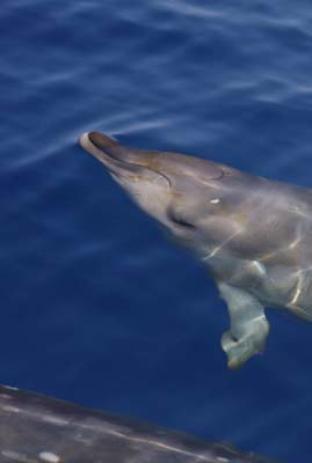Published in the Ocean Watch column, Honolulu Star-Advertiser © Susan Scott
August 30, 2010
 Two weeks ago when federal biologists, University of Hawaii researchers, a couple of veterinarians, about 30 volunteers, some flatbed truck drivers and the pilots and crew of a Coast Guard C-130 joined forces to get an ailing beaked whale to a marine mammal hospital on the Big Island, a lot of us Hawaii residents had one burning question: What is a beaked whale?
Two weeks ago when federal biologists, University of Hawaii researchers, a couple of veterinarians, about 30 volunteers, some flatbed truck drivers and the pilots and crew of a Coast Guard C-130 joined forces to get an ailing beaked whale to a marine mammal hospital on the Big Island, a lot of us Hawaii residents had one burning question: What is a beaked whale?
It’s a common question because beaked whales don’t often show themselves to humans. These whales rarely breach, have a low, scattered blow and regularly dive to 3,000 feet and below, staying there up to 90 minutes.
But just because they’re out of sight doesn’t mean they’re rare. With 21 species and counting, beaked whales make up nearly one-fourth of the 86 known cetaceans (whales, dolphins and porpoises). And there likely are more. Since the development of molecular analysis and ongoing efforts by field scientists to get biopsy samples, the world’s knowledge of beaked whales is expanding.
Beaked whales get their name from their snouts. Like bird and dolphin beaks, these whales’ snouts vary widely in size and shape according to species.
The beaked whales’ distinction is in their teeth and jaws. Beaked whales are considered toothed whales, but females’ teeth never erupt from the gums and males generally have only two teeth. In several species the teeth rise from the gum of the lower jaw, like tusks, at the front or sides of the mouth.
Sometimes the protruding teeth point a little forward, but mostly they stick up. Gooseneck (aka stalked) barnacles tend to grow on the constantly exposed teeth, causing the whale to look like it has a bunch of feathery flowers sprouting from each side of its mouth.
But there’s nothing feathery about the stems in those bouquets. Judging from the extensive long, crisscross scars on the males’ bodies, researchers believe that the males use their tusklike teeth in fights with other males.
As for eating, since beaked whales lack functional teeth, they use suction to draw their prey of squid and fish into their mouths.
For the last 10 or so years, a team of research biologists has been studying the beaked whales found in Hawaii, photographing, tagging and taking DNA samples of the animals, mostly off the Big Island’s Kona Coast.
The most common species here is Blainville’s beaked whale, about 14 feet long. The scientists estimate that about 140 individuals live in our vicinity. The second most common is Cuvier’s, 9 feet long, with about 55 individuals here. Hawaii’s third beaked whale, Longman’s, is seen less often and needs more study.
Robin W. Baird of Cascadia Research Collective, a scientific and educational organization based in Olympia, Wash., heads the beaked whale (and other species) research team. Baird shared his picture of this endearing young Blainville’s beaked whale with me with this request: He’s looking for photos of beaked whales in Hawaii’s waters.
You can contact Baird about photos, and check out the team’s amazing pictures of these special whales in Hawaii, at www.cascadiaresearch.org/hawaii/beakedwhales. htm#pubs
As of this writing, the Blainville’s beaked whale being cared for at the University of Hawaii Hilo’s cetacean rehab facility is alive and swimming. Along with everyone, I’m rooting for her to recover, but already she has given her clan a great gift. As a result of her stranding, more of us now know about, and appreciate, another group of Hawaii’s native marine mammals.